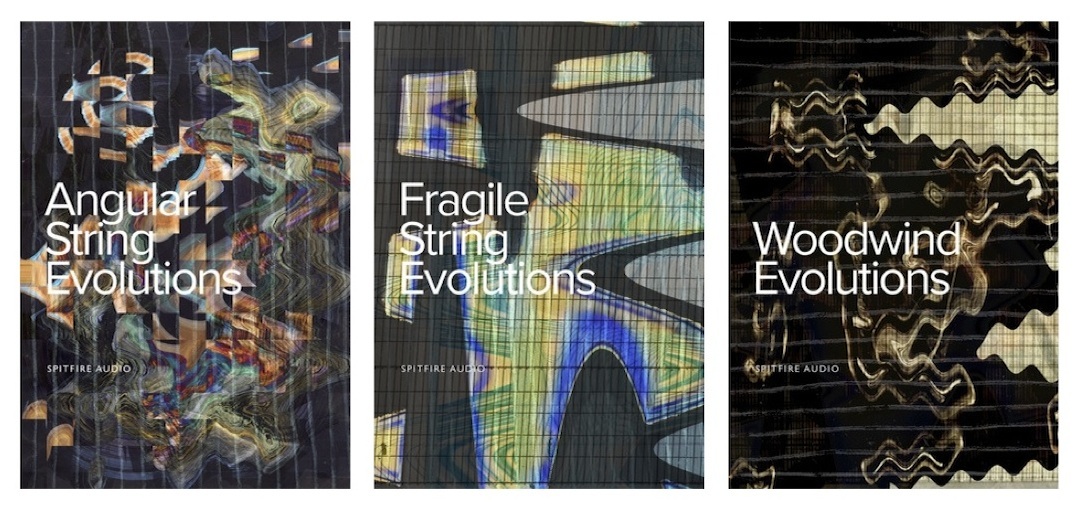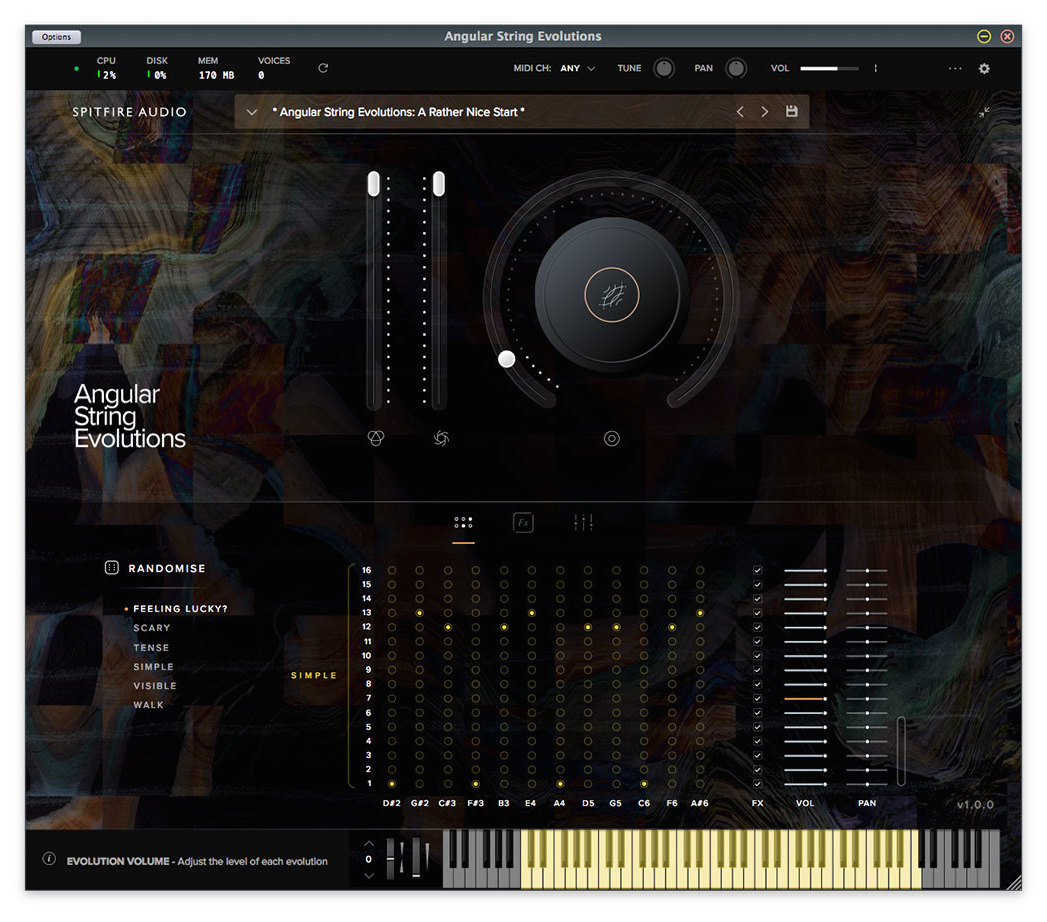New Software Review: Angular String, Fragile String & Woodwind Evolutions by Spitfire Audio

Utilizing the powerful Evo Grid architecture, Spitfire Audio furthers the Evolutions libraries with Angular String, Fragile String, and Woodwind Evolutions.
Part of the beauty in sampling is the ability to capture sounds, techniques, and articulations that real ensembles and players might not be able to easily replicate in a live performance. Spitfire Audio, well-known for being at the cutting edge of the sampling world, has taken this approach and applied it to their incredibly successful Evolutions libraries.
The basic philosophy of these products is that they revolve around the idea of recording long notes that slowly and subtly evolve over time. Incredible textures and soundscapes emerge from these transitions between different techniques and articulations, offering composers and producers extremely realistic sounds to use in their work.
These Evolutions libraries utilize Spitfire’s custom Evo Grid interface, which is inspired by the EMS VCS3 synth grid layout. The Evo Grid has a 12×48 grid arrangement that allows you to select between different “Evo” recordings across 12 intervals. This means if you hit the “Feeling Lucky” button, a random Evo will be triggered for each note—so playing a chord will yield different results every time you randomize the Evos.
To date, the full Evolutions bundle consists of Olafur Arnalds Evolutions, Olafur Arnalds, Chamber Evolutions, Spitfire Symphonic String Evolutions, Evo Grid 3 (Strings In Motion), and now three new reinvented libraries which we will discuss today.
Spitfire has taken three of their most popular Evolutions libraries (Evo Grids 1, 2, and 4) and repackaged them into Angular String, Fragile String, and Woodwind Evolutions. The previous iterations of these products were housed in Native Instruments’ Kontakt engine. These new versions are now housed in their own dedicated plugins, which resemble the Labs, Eric Whitacre, and HZ Strings plugins Spitfire has released over the past year and a half.
Today we’ll go over the features and sounds of these three new offerings, and discuss whether the new plugin interfaces are an improvement to their previous Kontakt versions, which many media composers still rely on today.
Features
As the Evo Grid interface is utilized across all of these libraries, let’s start by discussing the unique differences between each of them. Then, we’ll take an overview of the grid plugin interface.
Angular String Evolutions (Previously Evo Grid 1): Composed of minimal chamber strings that tingle and shimmer in a beautiful way, Angular String Evolutions will add an incredible intimacy to your scores and productions. Recorded in 2015, this library was composed of a 14-piece string ensemble (four 1st violins, three 2nd violinists, three violists, three celli, and one bass), and captured by the incredible Nick Taylor on tape through vintage microphones, Neve preamps, and a Cadac desk. Angular String Evolutions also comes with an additional 12 presets that weren’t present in the original Evo Grid 1 library.
Fragile String Evolutions (Previously Evo Grid 2): Fragile String Evolutions expands upon the previous library by focusing on extremes: more traditional sounding evolutions, as well as more chaotic aleatoric-leaning ones. Sonically, these extremes make for a lot of fun, especially when you randomize Evos between sane and chaotic articulations. 13 more presets are included to add to the original 10 in Evo Grid 2.
Woodwind Evolutions (Previously Evo Grid 4): Arguably the most different of the Evolutions libraries in that it was recorded with a woodwind ensemble as opposed to a string band, this final library has a ton of range and warmth. For this library, Spitfire recorded two different bands of wood players. The first consisted of three flutes, one alto flute, one bass flute, one contra bass flute, and three Bb clarinets. The second consisted of three oboes, two cor anglais, two Bb clarinets, one Bb bass clarinet, one baritone sax, and finally three bassoons. (As a side note, I would love more sax in orchestral libraries, and this one is certainly welcome!) Ranging from dark and moody to epic and soaring textures, this library covers a lot of ground—all while providing a sense of mysticism to your music.
Like most of Spitfire’s other offerings, all of these Evolutions libraries were recorded at the famous Air Edel studios in London. The new plugin interface includes a ”Stretch” feature which stretches the audio file by either two or eight times. The interface for all of these libraries appears similar in that it’s divided up into three sub-tabs: Grid, FX, and Signal Mixers + Controllers.
The built-in FX include a Tape Saturator, Delay, and Reverb. These can do a lot to add warmth and dimension to the samples, which were recorded slightly dry. The Signal Mixer allows you to blend between Close Mic, Tweaked (heavily compressed signal which sometimes glitches out), Ambient, Distorted, Stretch x2, and Stretch x8 signals. In this panel, you also have control over your normal ADSR, as well as a Variation fader which can modify the sound of the technique being played by moving the sample start point of the Evo.
Like most Spitfire libraries, mod wheel (MIDI CC1) is set at default to control dynamics so you can use it to create expressive performances. CC11 is set to control expression at default which can be thought of as a volume control, whereas dynamics actually changes the samples being triggered.
In Use
Angular String Evolutions has a simplicity that I find invaluable for accessing incredibly characterful string pads. I found the grid layout to be very intuitive to use. It offers easy access to a wide variety of different and evolving textures.
As mentioned, CC1 (mod wheel) is set to control dynamics and allows you to transition from soft to loud samples mid-performance. The library has some Evo notes with ricochets or col legno chattering that can really quickly add tension and suspense to your music.
The new plugin interface also allows you to not only blend close and ambient mics, but also to simultaneously blend in the stretched audio signals. So, for instance, if I want to add even more tension to the suspense—inducing Evolutions I mentioned earlier—I could opt to mix just the close mics for a drier character with the 2x stretched audio for an eerie texture.
Speaking of suspense and tension, I found Fragile String textures even scarier. The Overtone Shudders sounds can easily summon goosebumps (please don’t abuse this knowledge), and the subtle pitch movement gives off a delightfully creepy vibe. Additionally, the Woodwind Evos are generally warm and inviting, but they can also be made haunting via the more intricate airy Evos in the grid.
But how do we feel about the departure from the Kontakt platform?
To Be Critical
While I love these new interfaces, I can’t say that I was missing much in the Kontakt format previously. Having most of my orchestral libraries in Kontakt also offers a huge advantage in that I can switch sounds relatively quickly without having to reload a different plugin. If Spitfire keeps re-releasing their libraries in separate plugins, it’s going to be a pain to have to open a unique instance to switch between all my different Spitfire sounds—let alone all my other Kontakt libraries. Instead, I would hope that they make one Spitfire Audio plugin that can load all of their libraries from one interface.
It also slightly bugs me that Spitfire kept Evo Grid 3 as a Kontakt instrument because their custom plugin interface lacked a feature that couldn’t be replicated in the dedicated plugin format. Having said that, Evo Grid libraries in their own dedicated plugin offer the advantage of making it way easier to save favorite combinations of grid settings as presets. Being able to recall those favorites is invaluable (especially for film composers), and I found it much easier to do so with these new versions than within the original Kontakt format… so bravo, Spitfire!
Summing it Up
The Angular String, Fragile String, and Woodwind Evolutions libraries further Spitfire’s ever-increasing collection of dedicated plugins. While the new improvements may not be a necessity for owners of the original Kontakt versions, the new presets and time stretching features justify the slight increase in price to $299 each.
The delicate yet commanding character of these libraries really showcases what Spitfire does best: celebrating the subtle imperfections of real players. It is this element that can add invaluable layers of depth and realism to music created in the digital realm. Layering multiple Evolutions libraries together adds a sense of authenticity that is simply unattainable from other products.
While there are countless string and wind libraries available today, there are no other companies making products capable of doing what Spitfire has done with these three offerings.
Please note: When you buy products through links on this page, we may earn an affiliate commission.








[…] Part of the beauty in sampling is the ability to capture sounds, techniques, and articulations that real ensembles and players might not be able to easily replicate in a live performance. Spitfire Audio, well-known for being at the cutting edge of the sampling world, has taken this approach and applied Read more… […]